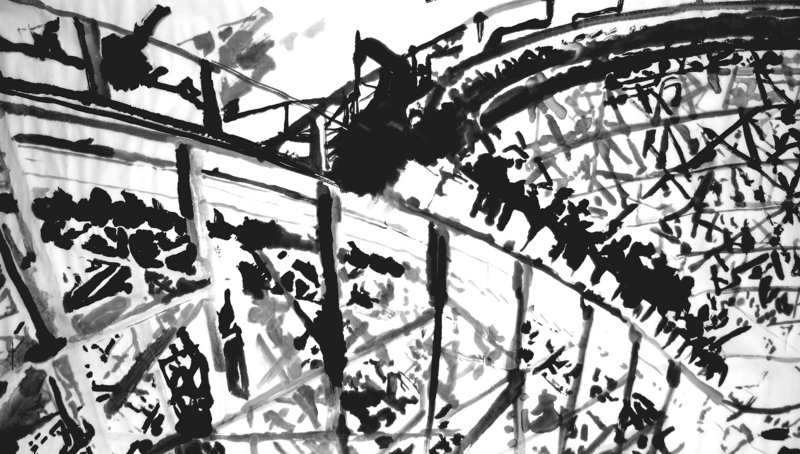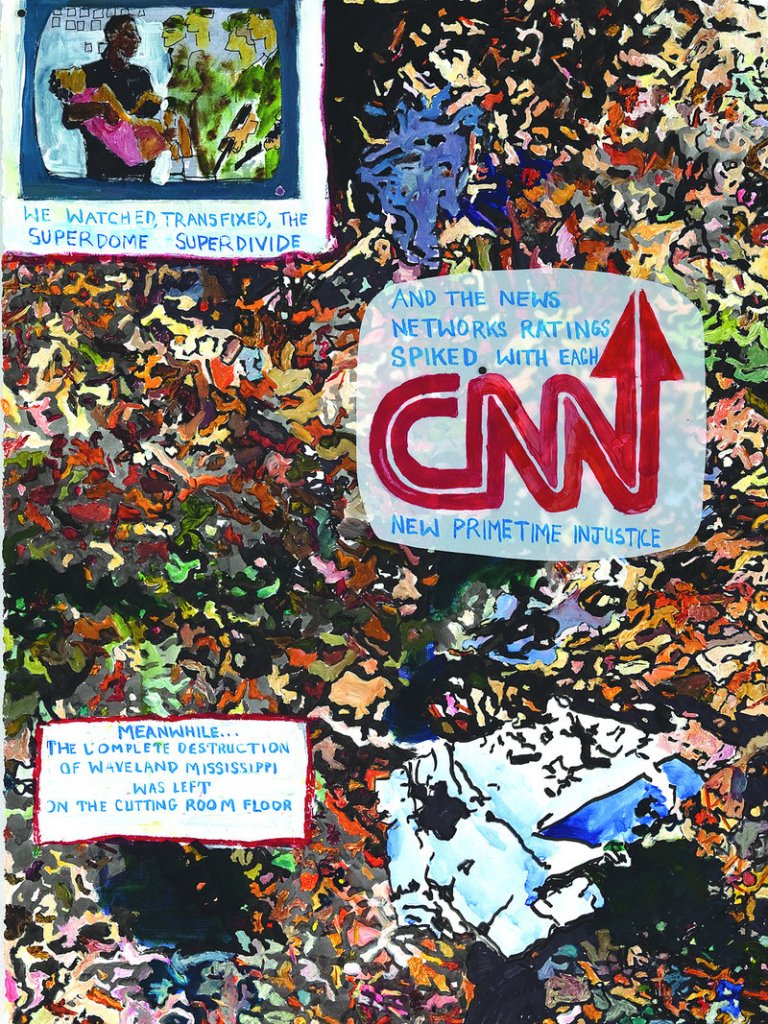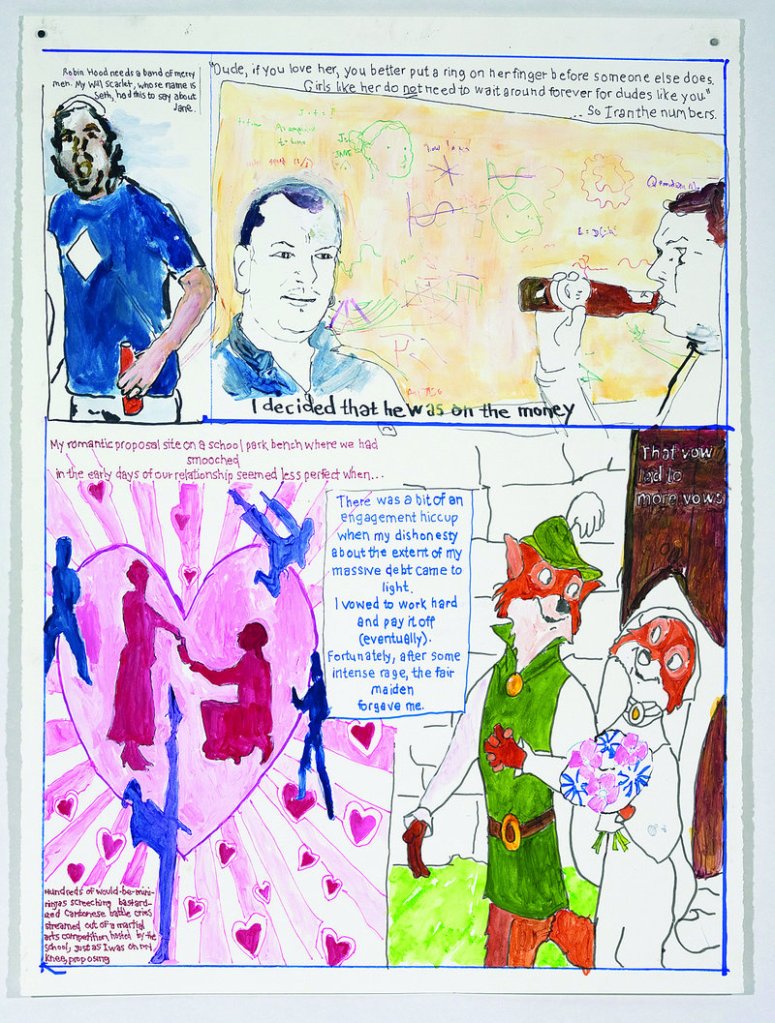What would happen if you lost everything?
When we were bringing toys to the fire station last week, one of my young sons asked whom they were for. For kids whose families had “lost everything in fires and hurricanes” answered my other son. While I filled in more of the truth about the Christmas gift program, I couldn’t help thinking about an exhibition now on view at UMA’s Danforth Gallery: Peter Precourt’s scrapingly honest autobiographical narrative, “The Katrina Chronicles.”
In 2005, Precourt (now a professor at UMA) sold his home in Houston and moved his family to Mississippi to take the painting chair at a small college overlooking the Gulf of Mexico. Less than a month later, he lost most everything to Katrina: his home, his studio and art materials — as well as virtually his life’s work in art and all its documentation.
Precourt’s 42 “Katrina Chronicles” works are mixed media (Prismacolor marker, acrylic, sumi-e, etc.) on 30-by-22-inch paper. They fall somewhere between paintings, drawings and folio pages. They tell his story with unblinking detail.
GRITTY HONESTY
Precourt’s pieces have the feel of blogging, newspapers and the gritty tone of the graphic novel. As autobiographical documents, they might startle much of the public audience as shockingly honest, but this is what distinguishes Precourt as an artist. Rather than the whitewashed (and ghostwritten) “autobiographies” we get from so many flag-wrapped politicians and celebrities, Precourt’s is told in the honest voice of a guy talking to a close friend — or himself. If you read all of the text in the paintings — it took me an hour to go through piece by piece, and it was absolutely worth it — you quickly move past the initial awkwardness of his abrupt intimacy to admire his insightful authenticity. Such a way of speaking, however, has been mediated by many recent changes in public culture: reality TV, blogging, Internet news, relentless paparazzi, and, as much as anything else, Gonzo journalism. But Precourt is warmly genuine — and interesting — so it fits him perfectly.
The seemingly casual pages are hung in order around the gallery, beginning with a title page and ending with a hilarious play on Michelangelo’s “Creation of Adam” with Precourt as Adam. We also see him once earlier as Spiderman and before that as Robin Hood — the rascally cartoon fox cavorting with his bride.
On the Robin Hood page alone, Precourt gets wise advice from a friend over beers, proposes to his wife in front of hundreds of screaming schoolchildren, hits an enraged engagement bump when she finds out about the extent of his debt, gets forgiven and then gets married.
But is it a good painting? No, if it needs to be pretty. Like most of Precourt’s work, it’s scratchy and a bit frenetic. However, if you value emotion, action and insight, then it’s amazing.
One of Precourt’s best paintings is a huge thumbprint. Easy to overlook, maybe, but very hard to get right and make for a handsome painting.
There is more than a bit of James Ensor in Precourt: When he bites, it hurts. One of the most poignant pages has a CNN logo and a small picture of black people facing off against white troops over the text “we watched, transfixed the Superdome divided/and the news networks ratings spiked with each new primetime injustice.” All this over a scene of (wonderfully painted) total destruction which, Precourt reports, was completely ignored.
The “Katrina Chronicles” give us jokes, jealousies, maps, airline schematics, floor plans, rendered photos, cartoon characters — all this and so much more in no fewer than 100 styles. Yet there is nothing showy in the countless hours of work that went into this still-growing body of work.
The center of the gallery features five large sumi-e drawings of dizzyingly wild roller coaster scenes. Intoxicating recklessness, they unfurl with an ironical awareness of traditional sumi-e. Precourt turned to the Japanese ink as a quick and inexpensive medium after Katrina and found its loose, calligraphic gesturality to be perfect for his spurtive narrativity. These drawings show Precourt’s mastery both of scenic composition and traditional metaphorical content (life as a roller coaster).
American art since Surrealism came to town has always been about self-examination and self-expression, but it has completely changed: The power of myths and heroes has been usurped by job searches, marital strife and taking care of well-loved but sometimes grumpy babies.
This may not sound like holiday art, but at Christmas, even very young children learn to reflect on themselves and their actions (Have I been naughty or nice? What do I want? What do I deserve?). They learn about giving and compassion for anonymous others. At New Year’s, we look back at the previous year and make personal resolutions.
The holiday season is absolutely a time of self-contemplation — and Precourt is a master.
While not a show for children, “The Katrina Chronicles” is fascinating, brilliant and, at times, quite moving. If you are up for a challenge, you should not miss this show.
Freelance writer Daniel Kany is an art historian who lives in Cumberland. He can be contacted at:
dankany@gmail.com
Send questions/comments to the editors.





Success. Please wait for the page to reload. If the page does not reload within 5 seconds, please refresh the page.
Enter your email and password to access comments.
Hi, to comment on stories you must . This profile is in addition to your subscription and website login.
Already have a commenting profile? .
Invalid username/password.
Please check your email to confirm and complete your registration.
Only subscribers are eligible to post comments. Please subscribe or login first for digital access. Here’s why.
Use the form below to reset your password. When you've submitted your account email, we will send an email with a reset code.